


A Visit with Bob Parker: Dedicated Muzzleloader Bulletmaker
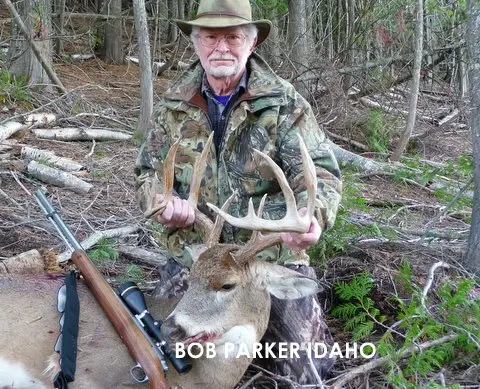
Bob Parker hails from Troy, Idaho, and spends his time deep within his inner sanctum devising strange and unusual things. Aside from that, he specializes in bullets-- muzzleloading bullets, to be exact. Apparently, Bob's entry into muzzleloading bullets began in 1989 when Bob mused over the proper way to kill a hat at 300 yards. Bob's hat-killing experiments never materialized, but the result was the Parker Hydra-Con bullet that recorded its first kill in 1990 at about 250 yards. That was twenty-two years ago and since then Bob has broadened his line from what started with conicals to his best-selling whitetail projectile, the 275 grain saboted Ballistic Extreme to his latest creation, the flattest-flying projectiles ever devised for muzzleloading use: the Parker Match Hunter line.
RW: In the ebbs and flows of what is trendy, the big muzzleloading boom of the late 1980s and 1990s has long since diminished. It is a shame, though, for muzzleloading has never been easier or more effective than it is today. Many states, particularly east of the Mississippi have long allowed muzzleloaders not only in dedicated muzzleloading seasons, but alongside their “firearms” seasons which often do not allow center-file rifles at all, but just shotguns. Compared to a slug gun, you have essentially twice the range, less recoil, greater accuracy, and less cost per shot. It is mind-boggling that muzzleloading is often so sorely over looked, when it is often the best equipment for the quick, clean harvesting of game. Bob, what's your view on this?
Bob Parker: There is no question that a very effective and practical means of clean harvesting of game is being passed over when the muzzleloader is not considered. As you have clearly stated the accuracy, range extension, weapon effectiveness all makes the muzzleloader not only a useable tool, but the weapon of choice in states that allow its use. When you combine the rifle/scope/projectile/powder combinations available and the accuracy and terminal performance produced by projectiles available, the muzzleloading rifle merits serious consideration.
RW: By better muzzleloading components, I'm referring to sabots from MMP that are significantly stronger than a decade ago, propellants far more consistent and less corrosive (Blackhorn 209), and dedicated muzzleloading rifle bullets rather than just shoving cannelured pistol bullets down the bore and hoping for the best. Lots of people want the “best” load, whatever works best in their individual rifle would be the best, but they often want specifics-- specifics that the rifle manufacturers don't or won't provide. So, let's go down the line by brand and see what your experience has shown. Let's start with Thompson .50 caliber inlines, generally 1:28 rate of twist and generally with tight bores. I want to shoot a whitetail, what do you suggest? An elk or a bear?
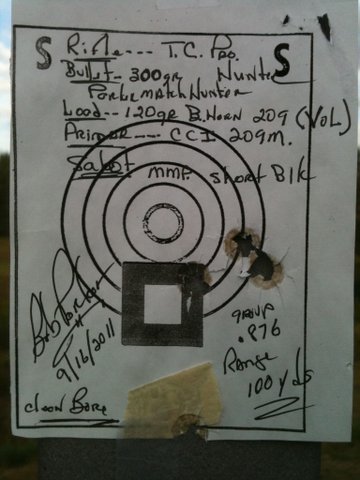
Bob
Parker: The Thompson .50 caliber inline is a very fine performer with
the present day projectile-sabot-powder combination. My particular T.C.
happens to be a Pro-Hunter and it performs flawlessly with saboted projectiles.
When I am hunting whitetail deer with the Pro-Hunter the bullet of choice
is the 275 gr. Ballistic Extreme. It gives a 1” 100 yd group on a
regular basis and is flatter shooting than the 250 gr., if you are shooting
in the 200 yds range. The terminal effect of the 275 gr. is also (for
me) desirable; it will expand readily and 95% of the time give complete
pass through. Couple this with 110-120 gr. of Blackhorn 209 and you have
a hard to beat combination. This is not to say the 250 gr. bullet is not
a good performer, it is. Accuracy wise it won the NMLRA/NRA Championship
in 2008, 2009, 2010 and 2011.
The particular characteristic of the 250 gr. BE that some find undesirable is the inability to give complete penetration all the time. It is very accurate, expands readily, and usually transfers all its energy to the game, but sometimes there is not an exit hole making provision for a better blood trail. As a rule it will give a quick one shot kill with minimal distance traveled. I would be remiss if I did not mention the Hydra Cons. They come in 250, 275, 300 gr. weights all are very effective on game. The 275 and 300 gr. bullets producing rapid expansion and complete penetration on most game.
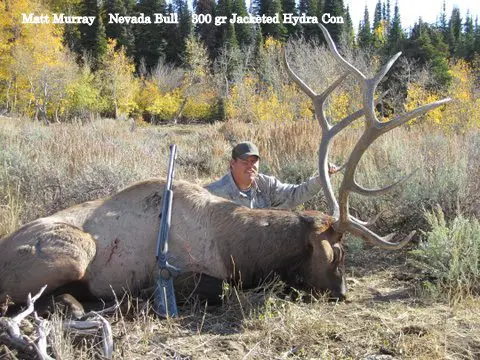
In regards to elk and bear: For bear, I would use the 300 gr. Hydra Con and if we are talking large bear the 300 gr. Match/Hunter. If the purpose is to break the animal down, the ticker jackets of the Match/Hunter is desirable. I believe the 300 gr. bullet, to be the best choice. For standard “stand over bait” hunts the 300 gr. Hydra Con will give great expansion, good penetration although complete pass through may or may not be a reality, as you know, the elasticity of a bears skin takes a lot of punch to penetrate on exit.
For elk, the 275 BE behind the shoulders is a good and effective choice. If you are one who shoots shoulders whether point of shoulder or high shoulder shots one of the 300s would be desirable. The Match/Hunter will expand moderately and penetrate deeply (most likely completely) on elk at standard velocities. The 300 grs Hydra Con will perform well in almost any situation for elk. In field test with 130 gr. of Pyrodex pellets the 300 gr. Hydra Con would penetrate both plates of the hogs. No 300 grs Hydra Con bullet was recovered when testing on these very tough animals. We deliberately shot broad side in the plates; the kill was almost immediate and passed through completely.
In considering this, I might add for those who draw a “Western States Elk Tag” and are required to use a “lead bore size” projectile we do have a 475 gr. Bore Size Hydra Con that shoots well in the T.C. It will not perform like a sabot bullet, but accuracy in my Pro-Hunter was 1 ½ - 2” @ 100 yds. Needless to say the 475 gr. has power to spare for any game you might encounter. This projectile shoots surprising flat for its weight and terminal potential -0-@25 yds +3” @ 50yds +4@100 yds; -0-@150 yds and -18”@200yds. The hydraulic gives good expansion and penetration at the above ranges.
RW: What about the Knight / Green Mountain 1:28 barrels? Not quite as tight as T/C barrels, but generally smoother barrels with better conical accuracy.
Bob
Parker: What has been said regarding bullet choice in the T.C. applies
to the Knight and Green Mountain as well. There are a couple of
observations I would make concerning the Knight. In my experience with
the “One Bolt Recoil Rifles” a 150 gr. load did not shoot well.
When the powder charge is in the 100-130 grs (pydx or 777) accuracy was
very good, above that the groups opened up. Blackhorn 209 (100-110
grs. vol.) in the rifles I shoot proved extremely satisfactory. With any
weapon to find the best load, personal testing is required.
The second observation is in relationship to the conical; as you stated
the Knight is fine conical rifle, which makes it for me the weapon of
choice for Western States that have the “all lead, no more than twice
bore diameter in length” restrictions. Almost 15 years ago we developed
a line of conical for the Knight that complies with all western states
regulations and shoots very well. Needless to say the Hydra Con (Hydraulic
Conical) is very effective on all US game. These bullets come in 45, 50,
52 and 54 calibers and are especially suitable for the Knight. The Knight
Rifle is generally well made, user friendly and rugged enough for hard
conditions.
RW: What's the starting point for the generic, cheaper brands . . . CVA, Traditions, etc?
Bob Parker: Concerning CVA and Tradition Rifles, I have very little personal experience with the CVA. We did use a CVA in our original conical testing (along with Knight, TC, Remington, Austin-Halleck, Traditions), it shot very well. We do have many customers that shoot the CVA and report very good performance.
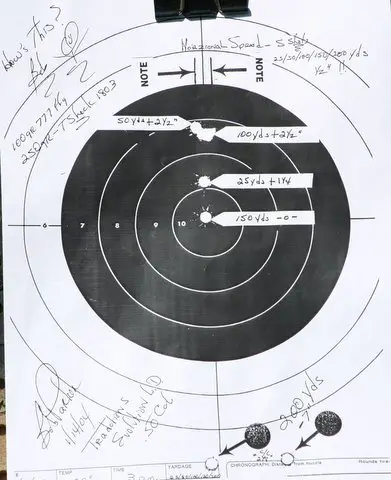
In regards to the Traditions, I have much personal experience. This experience does not cover the last few years, it ends the year the “Pursuit” was the new offering. We produced bullets for Traditions for several years; therefore, I tested each new model. The rifle is inexpensively made, but it will shoot! It shoots conical as well as sabots very well. In fact the best string of testing shots I have ever fired was with a Traditions Lightning Bolt. The string was one shot at 25, 50,100,150 and 200 yds. Testing for drop; the thing impressive was the horizontal spread- it measured ½ of 1” (target included if you wish to display it). The Traditions is a bit rough, often more laborious to disassemble and clean, but properly cared for all I tested shot very well with no failures.
RW: What about the sidelock / flintlock fellows with 1:48 rate of twist barrels and bore size conicals as mandated (strangely) by Colorado and a few other odd-ball states?
Bob Parker: Concerning the Hawken/Flintlock/Percussion rifles, let me simply say we have Western States legal bullets in 45-58 cal. I have both percussion and flinters; I would be pleased to chat with anyone that is working with what some call old—in my view “historically proven” weaponry. We also have the Hydra Con available for the Sharps. We can give a selection of alloy mix as well as bullet design, this is a “sleeping passion” for me; because of time usually all I do is dream about this area, but availability exists.
RW: Bob, as you well know, I have a special affection for the Savage 10ML-II .50 caliber inline and have taken more big game with it over the last decade than with all other rifles combined. What has been the results of your testing with your own Savage 10ML-II? What has yielded the most satisfying results for you?
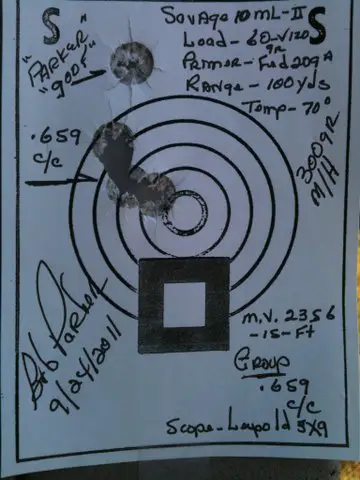
Bob Parker: I have found my Savage to be user friendly and very accurate. The projectile it seems to like best is the 300 grain Match/Hunter. Accuracy with this projectile is sub 3/4 inch and down range performance is very good. The load that works best in my personal rifle is 60 grains by weight of Vihtavuori N120.
RW: How important is jacket thickness of a bullet as applied to type of game and type of shot on that game (shoulder shot or heart/lung)?
Bob Parker: From my perspective, jacket thickness is a very important area and should be considered carefully, especially in a muzzle loading weapon. To begin with it is my opinion that “one bullet” will not always meet all needs. If hunting non-dangerous thin skin game, I prefer a light jacket quick opening projectile. I want the bullet to penetrate the rib cage, release its energy and exit. Sometimes that is a tall order, you can always get one or the other, but both quick expansion and exit sometimes do not go together.
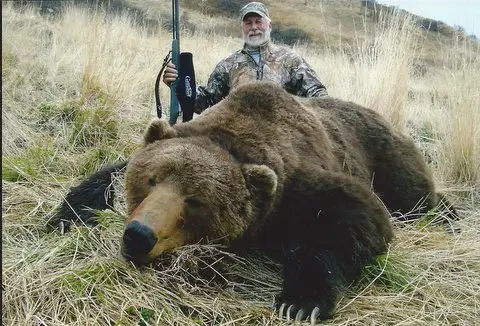
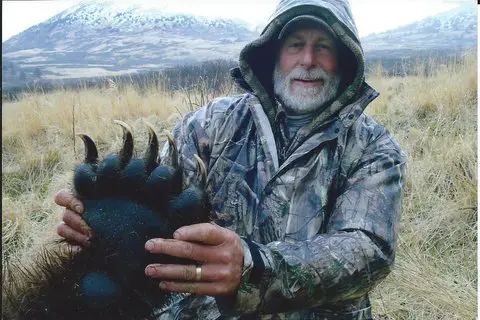
Above, a happy Duane Dunham with his one shot kill Alaskan Brown bear: 28-1/4 inch skull, squared right at ten feet. The one shot was with a Parker Match Hunter 300 grain bullet at about 100 yards. A real monster, this looks to be #2 in the SCI all-time muzzleloading record book. Via B & C, the bear is 28-3/16 in. which may well be the #1 NMLRA Longhunter record animal.
If a person’s preference is a point of shoulder or high shoulder shot a thicker jacket is desirable. In order to break bone and maintain its structural integrity the projectile has to be tough. The thin jacket bullet may very well kill in this circumstance, but for me when shooting where I know I will hit bone more jacket thickness is desirable. When you move to the dangerous thick skinned game, you need a thicker jacket for sure. Regardless of bullet construction, shot placement will always remain the primary consideration. If poorly placed no matter the projectile being used a clean humane kill is very unlikely.
RW: How long have you been using Spinjags and what have they done for you?
Bob Parker: I have used the Spin Jag for over 10 years. It is a very well made tool, sturdy in construction, practical in application. It loads the projectiles straight, simplifies cleaning, spins with the projectile as it loads avoiding stripping. The bullet starters are fantastic and I use them with all our bullets. I have found the product to be a very valuable tool. Over my shooting bench is a well stocked rack with various calibers of loading and cleaning equipment; no matter the rod or tool, they have one thing in common, all are equipted with a “Spin Jag”.
RW: How did the development of the Parker Match Hunter come about?
Bob Parker: The development of our bullet line is based on three key things, accuracy, flight performance and terminal energy transfer. This is what first brought us to develop and patent the Hydraulic Expansion System found in our Hydra Con line of projectiles. When these bullets were developed “high velocity muzzleloading” was not yet a consideration; to get a bullet to expand and transfer its energy was. Therefore, we developed a hunting bullet that would do just that. When the “high velocity” weapons began to appear our bullets especially the 275 Ballistic Extreme were used with good success, but in some cases it was explosive performance vs. controlled expansion. As the weapons and propellants became capable of more and more velocity the need for a bullet equal to the rifle’s capability was called for. It needed to have a higher B.C. a thicker jacket, be deadly accurate, able to deliver acceptable terminal performance both near and far. Thus the Parker Match/Hunter, its creation was driven by practical necessity. It has proven to be a very worthwhile investment of time and resources.
RW: Bob, what is your current preference for muzzleloading propellants and how do you personally go about working up a load?
Bob Parker: In relationship to working up loads, I begin with the suggested minimum and work up. In general for most all other black powder weapons my go to powder is Blackhorn 209. I have found it to be extremely accurate and easy to both load and clean.

Copyright 2012 by Randy Wakeman. All Rights Reserved.

Custom Search

